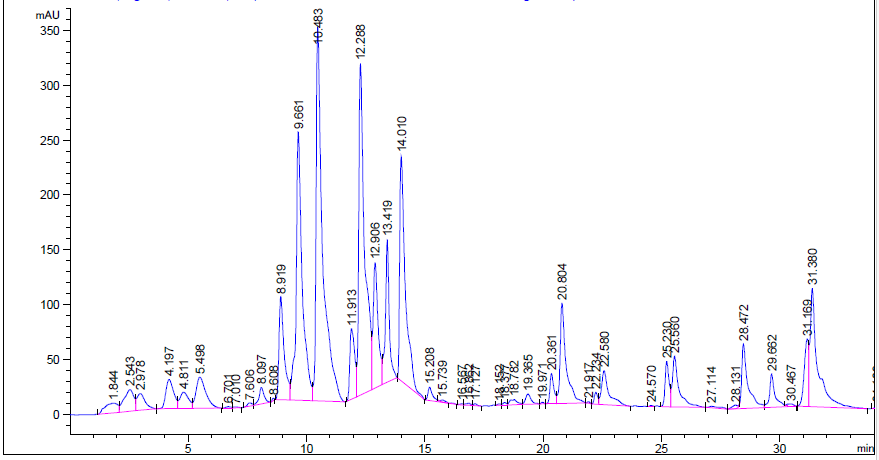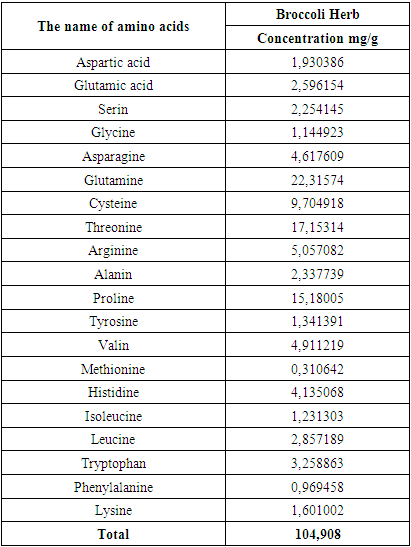-
Paper Information
- Paper Submission
-
Journal Information
- About This Journal
- Editorial Board
- Current Issue
- Archive
- Author Guidelines
- Contact Us
American Journal of Medicine and Medical Sciences
p-ISSN: 2165-901X e-ISSN: 2165-9036
2024; 14(1): 168-171
doi:10.5923/j.ajmms.20241401.36
Received: Jan. 15, 2024; Accepted: Jan. 30, 2024; Published: Feb. 2, 2024

Analysis of Amino Acid Composition of the Grass Brassica Oleracea var. Italica Plenck
M. M. Boltaev1, F. S. Jalilov2
1Assistant Department of Pharmacology, Bukhara State Medical Institute named after Abu Ali ibn Sino, Uzbekistan
2Doctor of Pharmaceutical and Chemical Sciences (DSc), Professor, Faculty of Medicine, Head of the Department of Pharmacy and Chemistry, Alfraganus University
Copyright © 2024 The Author(s). Published by Scientific & Academic Publishing.
This work is licensed under the Creative Commons Attribution International License (CC BY).
http://creativecommons.org/licenses/by/4.0/

Broccoli herb is a rich source of biologically active substances. The objects of our study were the dried grass Brassica Oleracea var. Italica Plenck (supplier of agricultural enterprise YAKKA-BURGUT, Samarkand region, Jambay district), assembled in November 2022. For the first time, the amino acid composition and definitely the quantitative content in broccoli grass were studied using high-performance liquid chromatography. The presence of 20 amino acids has been established, 9 of which are essential. The results indicate the prospects of using the vegetative and generative parts of the plant.
Keywords: Grass Brassica Oleracea var. Italica Plenck, Amino acids, High performance liquid chromatography
Cite this paper: M. M. Boltaev, F. S. Jalilov, Analysis of Amino Acid Composition of the Grass Brassica Oleracea var. Italica Plenck, American Journal of Medicine and Medical Sciences, Vol. 14 No. 1, 2024, pp. 168-171. doi: 10.5923/j.ajmms.20241401.36.
1. Introduction
- According to experimental data, it is known that broccoli has a high protein content, which includes the anti-sclerotic substances choline and methionine, as well as essential amino acids such as lysine, methionine, valine, isoleucine, leucine, threonine, phenylalanine; replaceable - tyrosine, histidine, alanine, arginine, aspartic acid, glycine, glutamic acid, proline, serine. In terms of the amount of protein, broccoli is superior to sweet potatoes, potatoes, sweet corn, asparagus, and spinach [1,2,3,4,5].The content of total protein in broccoli was qualitatively and quantitatively determined. A qualitative reaction (biuret reaction) with an alkaline solution of copper (II) salts with the formation of a violet color confirmed the presence of protein in the raw material. For a quantitative protein study, a protein isolate from broccoli was prepared [8,9,10,14].Quantitative determination of protein in raw materials was carried out using the Bradford method with the Kumasi reagent and 6.09 g of protein per 100 g of dry raw materials was found. To quantify protein in raw materials, the microbiuret method with Benedict's reagent was used and 18.6 g of protein per 100 g of dry raw material was found. The protein content in broccoli is not inferior to protein of animal origin, for example, a chicken egg contains 13 g of protein per 100 g of product [6,7,11,12,13].Purpose of the study. Analysis of the amino acid composition of the grass Brassica Oleracea var. Italica Plenck to determine the possibility of using broccoli herb growing in the territory of the Republic of Uzbekistan in medical practice.
2. Materials and Methods
- The objects of our study were the grass Brassica Oleracea var. Italica Plenck (supplier of the farm "YAKKA-BURGUT", Samarkand region, Jambay district), assembled in November 2022.The raw materials were dried at room temperature in a well-ventilated area for ten days [15,16] and stored in paper bags.Precipitation of proteins and peptides from the aqueous extract of the samples was carried out in centrifuge beakers. To do this, 1 ml (exact volume) of 20% TCA was added to 1 ml of the test sample. After 10 minutes, the precipitate was separated by centrifugation at 8000 rpm for 15 minutes. 0.1 ml of the supernatant was separated and freeze-dried. The hydrolyzate was evaporated, the dry residue was dissolved in a mixture of triethylamine-acetonitrile-water (1:7:1) and dried. This operation was repeated twice to neutralize the acid. By reaction with phenylthioisocyanate, phenylthiocarbamyl derivatives (PTC) of amino acids were obtained according to the method of Steven A., Cohen Daviel [17]. Identification of amino acid derivatives was carried out by HPLC. HPLC conditions: Agilent Technologies 1200 chromatograph with DAD detector, 75x4.6 mm Discovery HS C18 column. Solution A: 0.14 M CH3COONa + 0.05% TEA pH 6.4, B: CH3CN. Flow rate 1.2 ml/min, absorption 269 nm. Gradient %B/min: 1-6%/0-2.5min; 6-30%/2.51-40min; 30-60%/40.1-45min; 60-60%/45.1-50min; 60-0%/50,1-55 min.
3. Results and Discussions
- The results of the determination of the amino acid composition of the broccoli herb (Brassica Oleracea var. Italica Plenck) are presented in Table 1 and in Figures 1, 2.
|
 | Figure 1. Chromatograms. Amino Acid Standards |
 | Figure 2. Chromatogram of amin o acids of the grass Brassica Oleracea var. Italica Plenck |
4. Conclusions
- For the first time, the amino acid composition and definitely quantitative content of broccoli grass (Brassica Oleracea var. Italica Plenck) grown on the territory of the Republic of Uzbekistan. The results indicate the prospects of using the vegetative and generative parts of the plant.
 Abstract
Abstract Reference
Reference Full-Text PDF
Full-Text PDF Full-text HTML
Full-text HTML